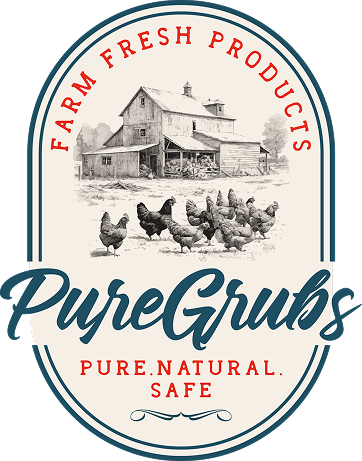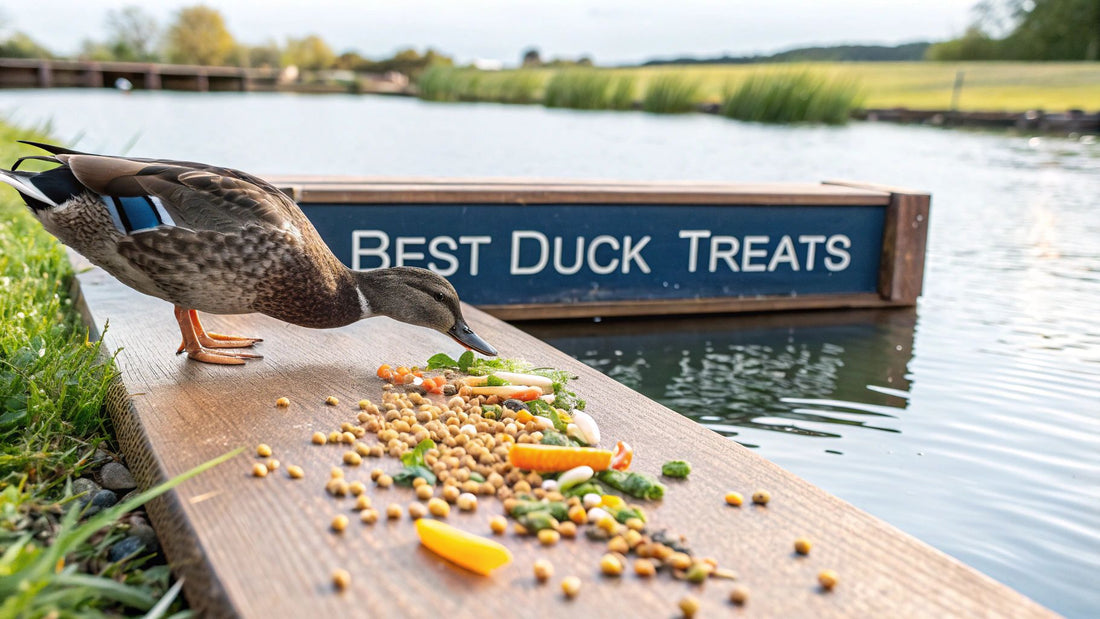
The Best Treats for Ducks A Complete Feeding Guide
Share
When you're thinking about treats for ducks, things like cracked corn, oats, chopped lettuce, peas, and protein-packed insects like Black Soldier Fly Larvae are at the top of the list. These are fantastic choices that give ducks the nutrients they need, unlike bread, which you should always skip.
Your Quick Guide to the Best Duck Treats
It’s a classic scene: someone at the park, tossing pieces of a sandwich to eager ducks. While the intention is good, it’s one of the worst things you can do. Bread is pure junk food for waterfowl. It fills their bellies but offers absolutely no real nutrition, leading to serious health issues like malnutrition and "angel wing," a painful, irreversible wing deformity.
Think of it this way: you wouldn't fuel a marathon runner on a diet of donuts. Ducks need proper fuel, and the best treats are the ones that are closest to what they’d find foraging on their own.
What to Feed Ducks Instead of Bread
So, what should you bring to the pond or offer your backyard flock? Here are some safe, healthy alternatives that will actually do them some good.
- Grains and Seeds: You can't go wrong with uncooked oats, cracked corn, or a good quality birdseed. These are easy for ducks to digest and provide the carbohydrates they need for energy.
- Vegetables: Ducks absolutely go wild for chopped leafy greens. Think romaine lettuce, kale, and other vitamin-rich greens. Frozen peas and corn are also a huge hit—just make sure to thaw them first!
- Protein Sources: For a real nutritional boost, especially for laying hens, high-protein snacks are fantastic. Black Soldier Fly Larvae (BSFL) are a game-changer here. They're loaded with the protein and calcium ducks need for strong bones and even stronger eggshells.
For a deeper dive into building the perfect daily meal plan for your flock, check out our complete duck feeding guide. It covers everything you need to know.
This visual breakdown shows you exactly how to balance those supplemental snacks.
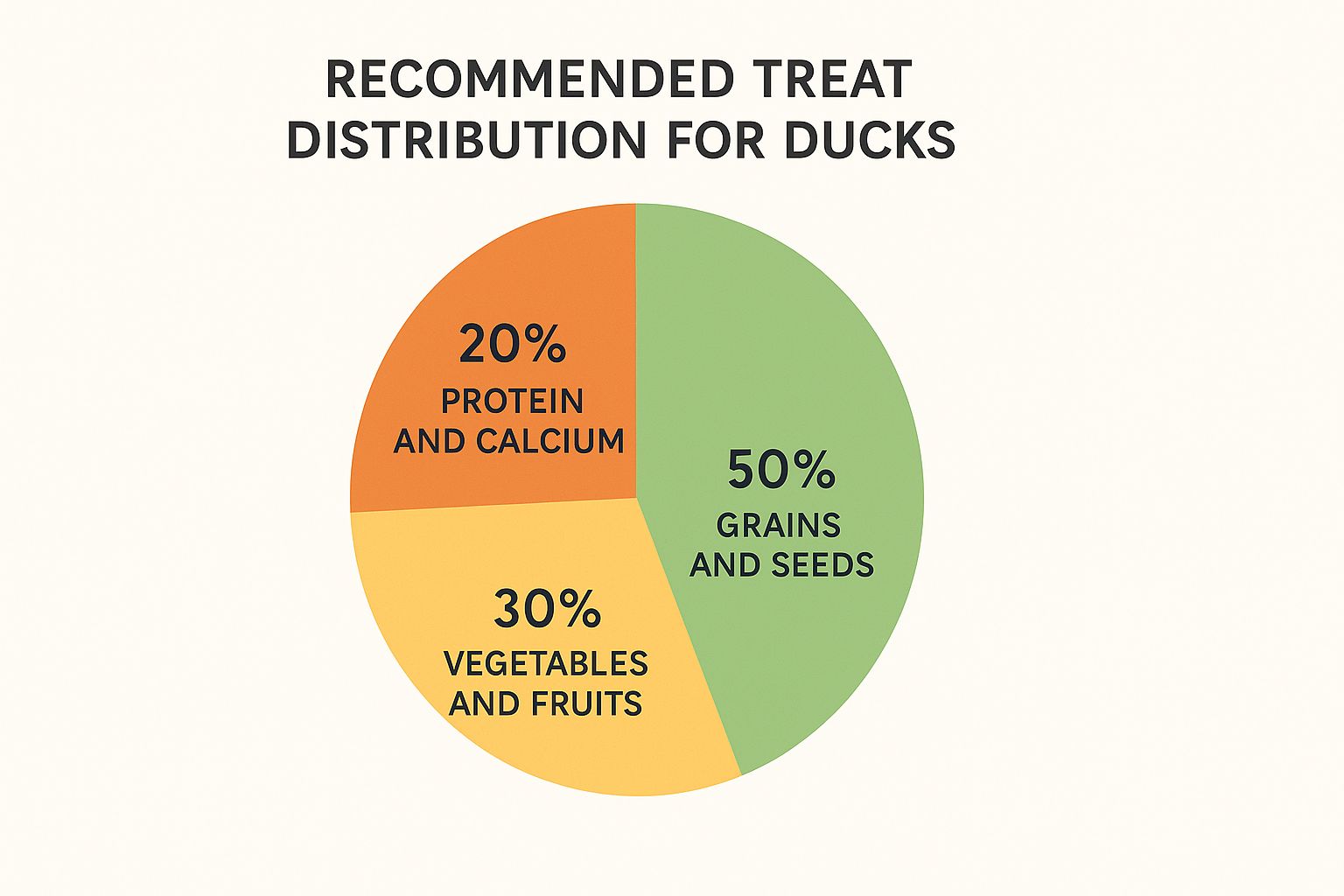
As you can see, the foundation of a good treat mix is grains, with a healthy portion of vegetables and a smaller, targeted amount of high-value protein and calcium.
Quick Guide to Safe and Unsafe Duck Treats
To make things even clearer, here’s a simple table to help you distinguish the good from the bad at a glance.
| Treat Category | Safe Options (Recommended) | Unsafe Foods (Avoid) |
|---|---|---|
| Grains | Cracked corn, oats, birdseed, cooked rice | Bread, crackers, cereal, donuts |
| Vegetables | Lettuce, kale, peas, corn, cucumber | Onions, garlic, avocado, raw potatoes |
| Fruits | Berries, melon, sliced apples (no seeds) | Citrus fruits, rhubarb |
| Protein | Black Soldier Fly Larvae, mealworms, earthworms | Processed meats, salty snacks |
| General | Chocolate, caffeine, alcohol, junk food |
Keeping this simple guide in mind ensures you’re helping, not harming, your feathered friends every time you offer them a snack.
Understanding a Duck's Natural Diet
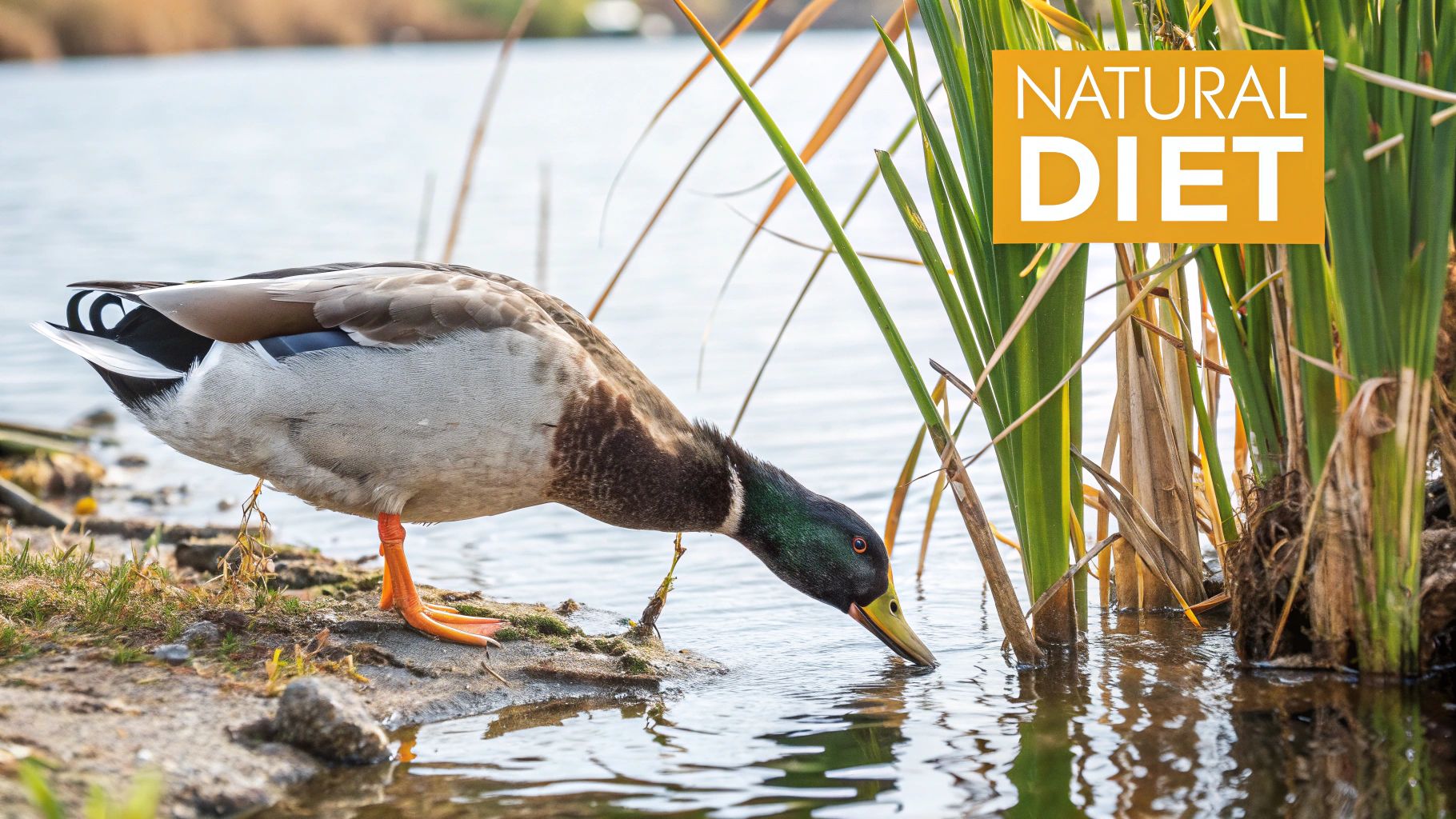
Before we can pick the best treats for our ducks, we need to get inside their heads a little bit. Try to picture a duck on a mission, paddling across a pond or waddling through a damp field. What are they actually looking for? It turns out their diet is incredibly varied; ducks are expert foragers and true omnivores.
This means they thrive on a rich mix of both plants and animals. A wild duck’s menu is a buffet served up by Mother Nature herself, changing with the seasons and what’s available. Grasping this instinct is the secret to offering treats that actually boost their health, not just fill their bellies.
The Forager's Menu: What Ducks Eat in the Wild
In their natural habitat, ducks are busy. A huge part of their day is spent actively searching for food. You'll see them dabbling at the water's surface, dunking their heads completely underwater, and digging around in muddy banks for all sorts of tasty morsels. It's a diet perfectly balanced for their needs.
Here's a look at what they typically find:
- Aquatic Plants: Ducks love munching on things like pondweed, algae, and wild celery. These greens are packed with essential vitamins and fiber.
- Seeds and Grains: They're always on the lookout for seeds from grasses and other plants, which give them the carbohydrates they need for energy.
- Insects and Larvae: This is a huge one. Much of their protein comes from insects, worms, slugs, and larvae found in and around water.
- Crustaceans and Mollusks: Little critters like snails and crayfish provide vital calcium and protein, which is absolutely critical for strong bones and solid eggshells.
- Small Fish and Amphibians: If they get the chance, ducks won't hesitate to gulp down small fish, tadpoles, or even frogs.
This diverse menu shows us that ducks are hardwired to find foods rich in protein, calcium, vitamins, and fiber.
Why Mimicking Nature Matters
When we step in with treats, our goal should be to complement this natural diet, not replace it with junk. Processed human snacks, especially things like bread and crackers, are the exact opposite of what a duck's body is built for. They’re full of empty carbs and low on real nutrition, which can cause some serious health issues down the line.
A duck's body is designed to process whole, natural foods. Giving them junk food is like asking a high-performance engine to run on sugar water—it simply doesn't have the right fuel to function properly.
By choosing treats that mirror what they’d find in the wild—like protein-packed insects, vitamin-rich greens, and wholesome grains—you’re directly supporting their biology. This is the "why" behind every healthy recommendation that follows. Understanding this foundation makes it so much easier to choose treats that genuinely contribute to their well-being.
Grains and Seeds: The Foundation of a Duck's Treat Diet
Grains and seeds are the absolute cornerstone of a great treat plan for your ducks. It makes sense, right? This is the kind of stuff they’d naturally spend their days hunting for in the wild. Think of these as the reliable, energy-packed staples in their snack rotation.
We're talking about more than just scattering some generic birdseed. The right grains provide the essential carbohydrates that fuel a duck's busy day—all that swimming, foraging, and preening takes a lot of energy!
For years, people thought throwing bread to ducks at the park was the right thing to do. We now know better. Wildlife experts have been clear that bread is basically junk food for ducks, offering almost zero nutritional value and even leading to serious health issues like malnutrition.
A handful of something like cracked corn, on the other hand, delivers around 7%-10% crude protein and gives them real, sustained energy. It’s an infinitely better choice that actually supports their health. You can dig deeper into duck nutritional needs with this market research.
Getting the grains right is your first step to becoming a duck-treat expert.
Top Grains and Why They're a Hit
Not every grain is a winner in a duck's book. You want to offer things that are easy for them to digest and are loaded with the right kind of fuel. Here are some of the best choices for your flock:
- Cracked Corn: This one's a classic for a reason. Ducks go crazy for it, and it's a fantastic source of high-energy carbs. Just make sure it's cracked—whole kernels can be a real struggle for them to swallow and digest.
- Oats: Whether rolled or steel-cut, oats are a fantastic option. They’re a great source of fiber to keep their digestive systems running smoothly and pack in valuable nutrients like magnesium and zinc.
- Barley and Wheat Berries: These grains are perfect for adding a little variety. They're rich in both fiber and protein, and their different textures keep your ducks engaged and happily foraging.
- Uncooked Rice: It might surprise you, but uncooked rice (white or brown) is a perfectly safe and simple treat. While cooked rice is okay too, the uncooked kind is an easy-to-store option they'll gladly gobble up.
These grains act as the main fuel source in their treat allowance, giving them the stamina they need to be happy, active ducks.
Think of grains as the slow-burning logs in a duck's internal furnace. They provide steady, consistent energy all day long, completely unlike the quick, empty flash you'd get from a sugary or processed snack.
How to Prep and Serve Grains
The how is just as important as the what. Your goal is to make these treats easy and safe for your ducks to eat, avoiding any potential choking hazards or digestive upset.
A good rule of thumb is to keep everything small enough for a duck to swallow without a problem. Scattering the grains on the ground is a great way to tap into their natural foraging instincts. It keeps them busy and mentally stimulated as they peck around searching for goodies.
On a hot summer day, try mixing the grains with a little water to make a fun "porridge." They'll go wild for it, and it helps them stay hydrated. Just remember, treats are treats. They should only be a small supplement to their main feed, never the main course.
Nutritious Vegetables and Fruits for Your Flock
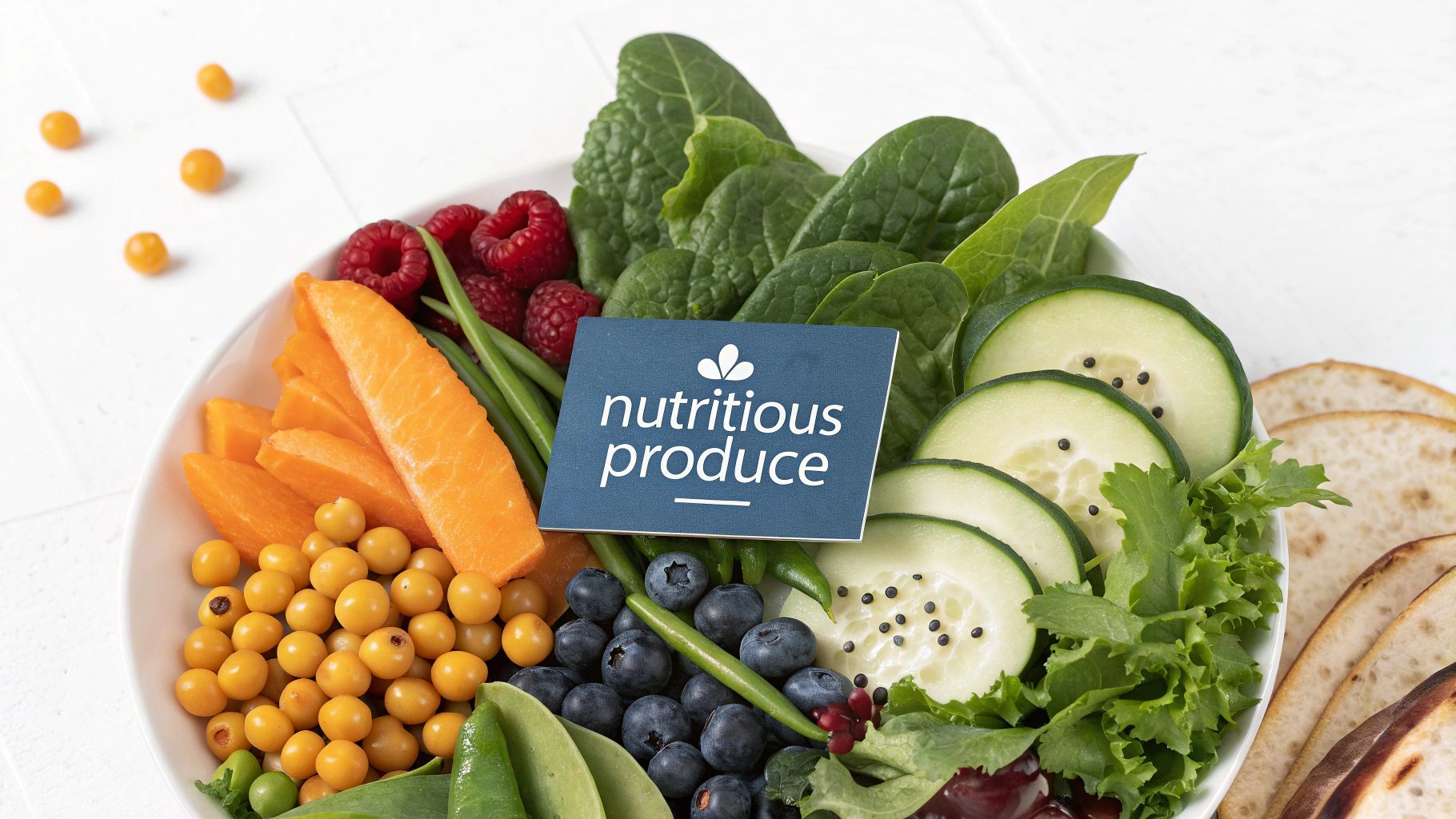
While a good quality crumble or pellet provides the foundation, fresh produce is what takes your ducks' diet from good to great. Think of it as their daily salad bar—a source of essential vitamins, minerals, and much-needed hydration that keeps their immune systems strong and their feathers looking sharp.
This wasn't always common practice. For years, duck treats were mostly just extra grains. But as we've learned more about animal nutrition, it's become clear that a varied diet makes a huge difference. In fact, studies going back decades showed that farmers who supplemented with simple leafy vegetable scraps saw their flocks' growth improve by 12%-18%. It was a clear sign that a little green goes a long way. You can learn more about how far things have come by reading about the evolution of the global duck market.
Top Vegetable Picks for Ducks
Ducks absolutely go wild for fresh greens. When you’re picking out veggies, just remember to chop everything into small, bite-sized pieces to make sure no one chokes.
Here are a few flock-pleasers:
- Leafy Greens: Dark greens like romaine lettuce, kale, and Swiss chard are fantastic sources of vitamins A and K. It's best to skip iceberg lettuce, though—it’s mostly water and doesn't offer much nutritional value.
- Peas and Corn: These are a massive hit, whether you offer them fresh or thawed from frozen. Ducks love chasing them down, and they provide a good source of fiber.
- Cucumber and Zucchini: On a hot day, there's nothing better. These veggies are packed with water and are incredibly refreshing for your flock.
- Pumpkin and Squash: Once cooked, pumpkin and squash become a soft, easily digestible treat that's loaded with vitamins and antioxidants.
A Guide to Safe Fruits
Fruits are a real delicacy for ducks, but it's important to treat them as just that—a treat. Because of their natural sugar content, they're best served in moderation.
Fruits offer a sweet and nutritious boost, but moderation is key. Too much sugar, even from natural sources, can disrupt a duck's digestive system. Stick to a few small pieces per duck, a couple of times a week.
Things like berries, melon, and bananas are wonderful options. The golden rule is to always remove any large seeds or pits first. Apple seeds, for example, contain trace amounts of cyanide, so always core an apple before slicing it up for your ducks.
Foods That Are Always Off-Limits
Just as important as knowing what to feed your ducks is knowing what not to feed them. Some everyday foods are surprisingly toxic and should be kept far away from your flock.
Be sure to avoid these:
- Onions and Garlic: These contain compounds that can damage a duck's red blood cells.
- Avocado: Every single part of an avocado—the skin, flesh, and pit—is toxic to birds.
- Citrus Fruits: Oranges, lemons, and other highly acidic fruits can upset a duck's stomach and interfere with calcium absorption.
- Raw, Dried Beans: These contain a toxin that is very dangerous to birds unless they are thoroughly cooked.
Why Protein and Calcium Are Essential Treats
While grains and veggies are fantastic for energy and vitamins, protein and calcium are the absolute cornerstones of a healthy duck. You can think of them as the steel frame and concrete foundation of a building. Without a steady supply, a duck’s body just can't hold up, especially during demanding times like growth spurts and egg-laying season.
Protein is the fuel for everything from building strong muscles to producing new feathers—a process that takes a surprising amount of energy. At the same time, calcium is the star player in forming a strong skeleton and, for your laying ducks, creating tough, protective eggshells. Falling short on either of these can quickly lead to some serious health issues.
The Powerhouse of Protein and Calcium
When it comes to packing these critical nutrients into a treat, not all options are on the same level. One of the best things you can offer your ducks is Black Soldier Fly Larvae (BSFL). These little insects are a true nutritional powerhouse, loaded with high-quality protein and a ton of naturally occurring calcium.
Just picture a laying duck. Every single egg she lays pulls a huge amount of calcium from her system. If her diet doesn't replace it, her body has no choice but to steal that calcium from her own bones, leaving them brittle and weak. Giving her BSFL provides a direct, easy-to-absorb calcium source to build strong eggshells without sacrificing her own health.
Think of BSFL as a natural, all-in-one supplement. They give your ducks the protein they need for muscle and feather health, plus the vital calcium for strong bones and perfect eggs—all wrapped up in one delicious, digestible little package.
BSFL vs. Mealworms: A Clear Winner
People often compare BSFL to another popular insect treat: mealworms. While both provide protein, a quick look at the nutrition label tells the real story. Mealworms are high in phosphorus but have very little calcium. This nutritional imbalance is a big problem because high phosphorus can actually block calcium from being absorbed properly.
BSFL, on the other hand, have a naturally perfect calcium-to-phosphorus ratio. This means your ducks can actually absorb and use the calcium they’re eating, making it far more beneficial. In fact, BSFL can have up to 85% more calcium than mealworms, putting them in a different league for supporting bone and eggshell health. The same logic applies to other backyard birds; you can read more about the benefits of dried grubs for chickens to see how this plays out.
Here’s a quick rundown of why BSFL are the superior choice:
- Optimal Calcium Levels: They deliver the calcium ducks need to avoid weak bones and those frustratingly soft-shelled eggs.
- High-Quality Protein: Essential for muscle development, vibrant feathers, and overall energy.
- Balanced Nutrients: The ideal calcium-to-phosphorus ratio means your flock gets the maximum benefit from every bite.
By adding a high-quality protein and calcium source like BSFL to your ducks' treat routine, you're not just giving them a snack—you're making a direct investment in the long-term health and happiness of your flock.
Foods You Should Never Feed to Ducks
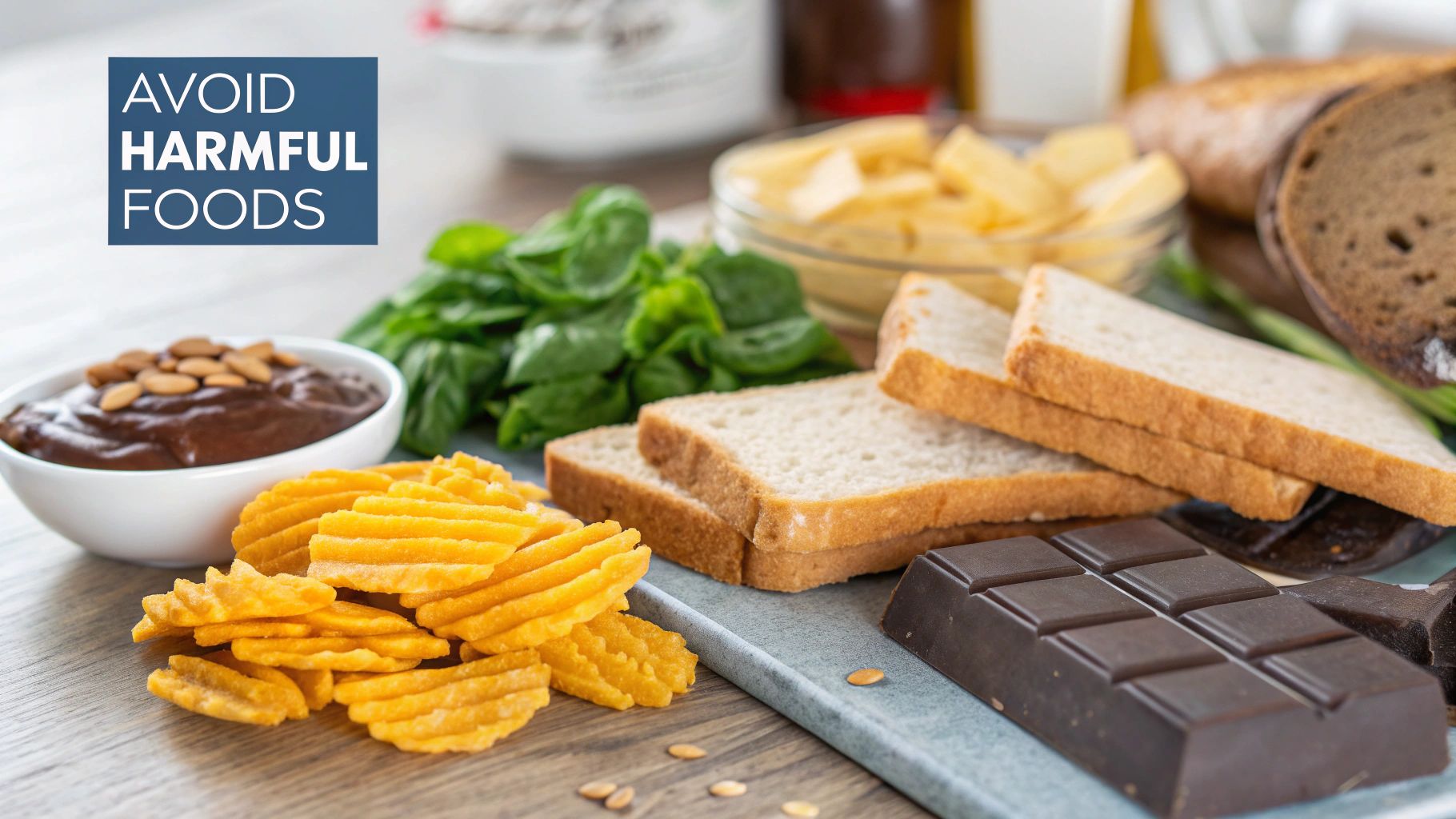
Knowing what treats are good for your ducks is only half the story. To be a truly responsible duck owner, you also need to know what's dangerous. Some common human foods can cause serious health issues, turning a kind gesture into a real problem for your flock.
The most famous offender, of course, is bread. Tossing bread to ducks at the park is a classic image, but it's one of the worst things you can do. Bread is essentially junk food for ducks—it fills their bellies without offering any real nutritional value.
When a duck fills up on "empty" food like bread, it won't forage for the nutrient-rich plants and insects its body actually craves. This can lead to a heartbreaking condition called "angel wing," a permanent deformity where the wing twists outward, making flight impossible. It's caused by a diet too high in calories and too low in essential vitamins and minerals during their crucial growing phase.
Beyond Bread: A List of Harmful Foods
It’s not just bread that poses a threat. A surprising number of items from our own kitchens can be harmful, and even toxic, to ducks.
A simple rule of thumb is to avoid anything processed, salty, sugary, or fatty. A duck's digestive system just isn't designed to handle the ingredients we find in our snacks and meals.
Think of it this way: giving a duck processed human food is like putting diesel in a gasoline engine. It might sputter along for a bit, but you're causing serious internal damage. Sticking to natural, whole foods is always the safest bet.
Your Quick Reference Safety List
To keep your feathered friends safe and healthy, here’s a list of common foods you should never offer. When in doubt, it's always better to skip it.
- Salty Snacks: Things like crackers, chips, and pretzels are a definite no. The high salt content can throw off a duck's electrolyte balance, leading to dehydration and serious kidney damage.
- Sugary Treats: Candy, cookies, donuts, and most breakfast cereals are full of empty calories that can lead to malnutrition and contribute to angel wing.
- Onions and Garlic: Both raw and cooked, these contain compounds that can destroy a duck’s red blood cells, causing a dangerous form of anemia.
- Citrus Fruits: The high acidity in fruits like lemons, limes, and oranges can irritate their digestive tract and interfere with proper calcium absorption—a critical mineral, especially for laying hens.
- Chocolate and Caffeine: These are highly toxic to most birds, including ducks. They can cause severe heart and nervous system problems that can be fatal.
- Avocado: Every part of the avocado—the skin, pit, and flesh—contains a toxin called persin, which is poisonous to ducks.
Keeping this list handy will help you make sure your treats are always a source of health and happiness for your flock, never a source of harm.
A Few Common Questions About Feeding Ducks
Even when you've got a good handle on the best treats for your ducks, some practical questions always seem to come up. Nailing down these details is all about building your confidence and making sure your feeding routine is safe, healthy, and actually doing your flock some good. Let's dig into some of the most common ones.
How Often Should I Give Ducks Treats?
This is probably the number one question I hear, and it all comes down to balance. How much is too much? A really simple and effective guideline to live by is the 10% rule. Treats should never account for more than 10% of your duck's total daily diet. The vast majority of their nutrition has to come from a properly formulated waterfowl feed.
Just think of treats as dessert—a special snack, not the main meal. A small handful once a day is a fantastic way to bond with your ducks without throwing their core nutrition out of whack. If you overdo it, you can end up with picky eaters and some serious nutritional problems down the line.
Can Ducks Eat Chicken Feed?
This one comes up a lot, especially for folks with mixed flocks of chickens and ducks. The short answer is yes, ducks can eat chicken feed in a pinch, but it's really not a good idea for their long-term health. The biggest problem is a single key nutrient: niacin.
Ducks need way more niacin than chickens do. It's absolutely critical for their bone and leg development, and a deficiency can cause crippling mobility issues. If you find yourself in a situation where you have to use chicken feed, you must supplement their diet with a niacin source, like brewer's yeast. In the same vein, making sure they have a great calcium source is just as important, similar to when you're looking for the best calcium supplement for chickens.
Is It Safe to Feed Wild Ducks?
Feeding the ducks at the local park might feel like a kind gesture, but most wildlife experts will tell you to avoid it. It seems harmless, but it can create dependency, cause unnatural overcrowding, and even help spread diseases among the birds. Plus, most people toss them unhealthy junk like bread.
Good nutrition makes a real difference. Research has shown that well-managed feeding programs can boost duck growth rates by 10%-15% and cut disease rates by nearly 20%. It just goes to show how vital proper food is compared to random handouts. If you absolutely can't resist offering a snack, make sure it's something appropriate like oats or peas, and only give them a tiny amount.
For a treat that delivers the high-quality protein and essential calcium your ducks need for strong eggs and healthy feathers, you can't go wrong with Pure Grubs. Our USA-grown Black Soldier Fly Larvae are a safe, nutritious, and all-natural choice your flock will love. Give them the best by visiting https://puregrubs.com to order today.
